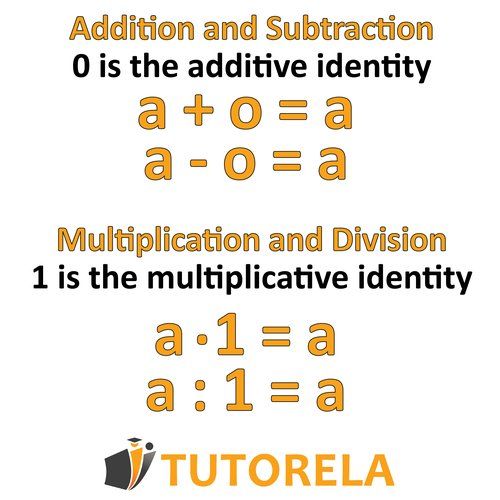The numbers and have some special characteristics when performing basic operations like addition, subtraction, multiplication, and division—including combined calculations.
In this article we will learn what they are and why they are important.

The numbers and have some special characteristics when performing basic operations like addition, subtraction, multiplication, and division—including combined calculations.
In this article we will learn what they are and why they are important.

Solve the following exercise:
\( 12+3\cdot0= \)
When we add zero to a number, it will remain unchanged because no value has been added to it.
The same happens when we subtract from a number: the number does not change because we are not taking anything away from it.
In multiplications, the result will always be .
We can summarize multiplication by as follows (whether it is multiplied by a positive or negative number):
and .
Even when dividing by another number, the result will always be .
and (Assuming that (a) is not ).
For addition and subtraction operations, 1 adds or subtracts one unit to the number.
,
,
,
For multiplications, when a number is multiplied by it will not change.
Something very similar happens with division: if we divide a number by one, the number remains unchanged.
Solve the following exercise:
\( 2+0:3= \)
\( 9 \times (2 \times 1) = \)
\( \frac{6}{3}\times1=\text{ ?} \)
After reviewing the characteristics of 0 and 1, let's try to use them to solve combined exercises according to the order of operations.
Calculate .
Solution:
We perform the division inside the first parenthesis before the power inside the second parenthesis.
We perform the additions and subtractions inside the first parenthesis (from left to right) and then the multiplication inside the second parenthesis.
We perform the subtractions.
We have obtained a multiplication of a number by one. Therefore, the result is:
If you are enjoying this article, you may also be interested in the following:
On Tutorela website, you will find a variety of useful articles on mathematics!
\( 0+0.2+0.6= \) ?
\( \frac{1}{2}+0+\frac{1}{2}= \) ?
\( 12+1+0= \) ?
They are numbers that have very important characteristics when we perform operations with them. 1 is known as multiplicative neutral and zero is known as additive neutral. This is because the numbers remain the same when you multiply them by one or add zero to them.
Zero in mathematics is used to represent the null value or absence.
Solve the following exercise:
\( 19+1-0= \)
\( 8\times(5\times1)= \)
\( 2+0:3= \)
Zero is an integer. It is neither positive nor negative and is used to represent the null value or as an origin in various situations.
Division by zero is not defined.
\( 0:7+1= \)
\( 12+3\times0= \)
Solve the following exercise:
\( 9-0+0.5= \)
Solve the following exercise:
According to the order of operations, we first multiply and then add:
Solve the following exercise:
According to the order of operations rules, we first divide and then add:
First, calculate the expression within the parentheses:
Now, multiply the result by 9:
Thus, the final answer is 18.
18
According to the order of operations, we will solve the exercise from left to right since it only contains multiplication and division operations:
?
According to the order of operations, the exercise is solved from left to right as it contains only an addition operation:
0.8